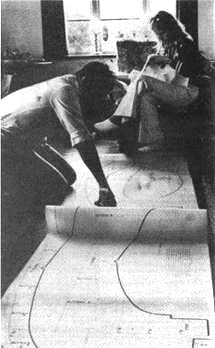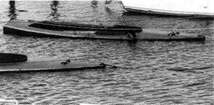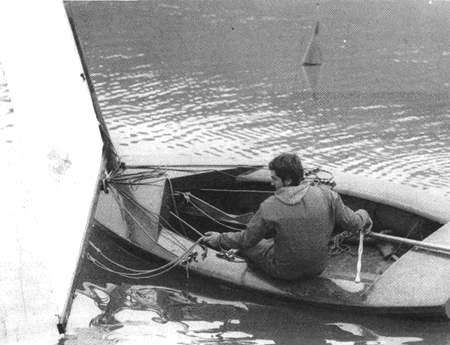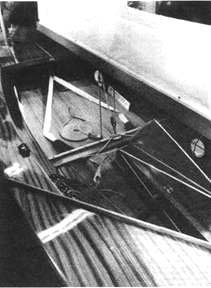1964
In November 1963 the IYRU discussed the proposals of the IFA Technical Committee in great detail and approved most of them to become effective from May 1 October 1964. There were not many substantial changes, but the lay-out was completely new, clearer and more rational. The rales gave exact instructions to boat owners, builders and measurers. The new set put greater responsibility on the owner to see that his boat was measured correctly and remained in class thereafter. The most important substantial change was the deletion of the former table of offsets from the rales, to be replaced by a new set of official templates. Such templates could be obtained from Fairey Marine through the IFA or produced locally from a set of drawings issued by Fairey Marine on a supposedly stable plastic material.
|
The side decks were redefined and cut-outs for the traveller prohibited. The traveller must not extend beyond the cockpit edge. Fifteen years later the same problem came up again and was solved in principle in the same way in detail in a slightly different manner. The shape of the centreboard was defined by the large and the small radius and the chord length. The lower mast bearing was allowed to be adjustable but any movable part had to be forward of station 7. The weight of the hull without floorboards, toestraps, centreboard and all other loose gear had to be above 105 kg. In the same condition the location of the centre of gravity was controlled longitudinally and athwartships. The total weight of all hull correctors had to be less than 10 kg. The building in of high or low density material in the hull was prohibited.
In this version of 1964 the mast hole was still to be measured from the stem and not from the transom, which was easier to measure, but inconsistent with all other hull measurements and contradicting the wording of other stipulations, that all measurements are taken from the transom. This new set of rules was complemented by a new measurement certificate, listing all the rales in a table with blank spaces to be filled in with the findings of the measurers, and - for the first time, fulfilling the suggestion of Richard Murray from 1958 - by 'Official Instructions to Measurers'. In these instructions to measurers it was pointed out that plastic boats can shrink. If new moulds were made from existing plastic boats (measuring correctly), the final outcome might turn out to be too small. In this version of 1964 it was still recommended that measurers locate the stations for template control by measuring along the keel, but not along the gunwhale. It was recommended to determine the position of the stations at the sheer by measuring directly from the transom to points on the deck. In addition to the 'Official Instructions to Measurers' a special leaflet 'Measurement Procedure for International Finn Class Boats' was produced.
|
 |
| Gilbert Lamboley studying the full size drawing of the templates |
|
After the first publication of the decisions of the IYRU from November 1963, the Technical Committee continued to work on the rales. Before the changes even became effective, some more discrepancies were discovered during 1964 and included in the further publications of the new rales. Most important was the definition of the overall length to be 4495 ±15 mm, and the regulation, that the fore side of the mast hole had to 3830 +5 mm, a few months later changed to 3825 +10 mm, from the transom.
|
In 1964 the Technical Committee was enlarged by the adoption of the measurer of the 1964 Gold Cup in Torquay, Vernon Forster. In the years to come, Vernon Forster became the Chief Measurer of the IFA and the terror- horror of builders and top competitors at major events. Forster did not develop new rales, but declared himself as the only authority in the interpretation of the established rales without any possibility of appeal. Meanwhile the new rales as approved by the IYRU in November 1963 were sent to National Authorities and translated into other languages.
|
 |
| Wetting down Finns at a Gold Cup |
|
The application of the new rules brought unexpected problems to builders, measurers and owners. The Technical Committee, mainly Richard Creagh-Osborne, personally considered every point with admirable patience, and handed in a further list of proposals for rule changes to the IYRU in November 1964. In November 1964 the IYRU approved a number of minor changes in the wording of the rales. Substantial alterations were the prohibition of centreboard slot sealing strips, the change in the measurement of the mast hole position (not any longer from the stem but from the transom), and the exclusion of hollow rudder blades or blades filled with lower specific gravity material.
1965
This revised version became effective January 1, 1965. A new 'Measurement Procedure for International Finn Class Boats' was issued along with the rule changes. The IFA and the IYRU recommended to call upon the newly created Class Measurer (Vernon Forster) in case a larger number of boats was to be measured or if specific problems had come up. In the version of 1965 the suggestion to determine the station points by measuring along the keel was finally abandoned. From now on the rules and the measurement instructions require both for the sheer and the keel points to measure parallel to the base line from the theoretical plane of station 0, in order to determine the position of other stations.
|
The revised set of rules was properly published, translated into several languages and put to work. At the 1965 Gold Cup in Gdynia, Poland, representative boats of several builders were completely measured. Several discrepancies were observed, mainly regarding the hull shape. Builders were warned, that the following year these boats will not be allowed to race in any major events. With the publication of the new rules in 1964/65 a significant process had taken one further step. In the beginning of the development of the Finn rules with the description of the 'FIN' by Rickard Sarby in 1949, there was a collection of descriptive information about the boat and only the passage about the weight of the dinghy was phrased as a restrictive minimum. By 1965 the rules were about three times as long as in 1949, but contained almost exclusively restrictive regulations and included only a few options. The objective of the rules had changed from an informative support for an interested amateur home builder to an incisive control system for semi-professional measurer to curb excesses of profit greedy shipyards.
|
 |
|
While the rales of 1951 to 1958 had a long section with suggested materials and dimensions in front of a brief section with limiting regulation, the rales of 1959 to 1963 consisted of a long restrictive section in front of a brief list of suggestions. After 1964 only a few options were mentioned on some of the rules. The home builder in good faith was left in the wilderness without guidance. In order to remedy this deficiency Richard Murray, IFA secretary up to 1961, and driving force of the rale changes in 1959/60, and Richard Creagh-Osborne published 'Hints for Home Constructors' in 1965. |
1966
In 1966 the new rales were published in a neat booklet, which included all the material agreed upon in the previous year. While the older boats remained genuine Finns in national and club races, the new measurement rules were enforced at the Gold Cup and the European Championship irrespective of the year the boat was claimed to have been built. At the AGM 1966 the delegates felt, that the new rales were too long and too complicated and therefore should be shortened and simplified. In addition strong forces called for more modern methods of construction like sandwich and double- bottoms. The main problems concerned the centre of gravity and the thickness of the hull.
|
1967
The simplification of the rales as proposed by the US was refused at the AGM 1967. However some smaller changes were adopted and later that year approved by the IYRU. The most important was the introduction of an additional control of the keel profile at station 1 with a tolerance of only +5 mm in order to cope with hollow sections in the aft portion of Raudaschl hulls. Furthermore it was decided at the 1967 AGM to ask the IYRU for permission to use alloy and reinforced plastic as a spar building material. The IYRU agreed in principle and asked for further experiments. Furthermore the IYRU asked the Finn Class to work on a method of controlling the distribution of structural weight in the hull.
1968
In 1965 several spars made of reinforced plastic or aluminium were produced and tested. The IYRU approved to allow these materials in 1969. The AGM 1968 decided to introduce 'Case Laws' as authentic interpretations of the rules by the Technical Committee. These case laws do not require approval of the IYRU.
|
 |
| A wood Taylor from the early seventies |
|
1969
At the AGM 1969 the representatives asked again for a revision of the rules governing the hull construction. Electronic and electrical aids other than a watch and compasses were banned.
1970
At the 1970 AGM in Cascais, Gilbert Lamboley was elected as the new Chairman of the Technical Committee, because Richard Creagh-Osborne was not able to continue. A decision of that AGM to free the boom to fit through a 85 mm circle and to increase the thickness of the rudder to 28 mm was later refused by the IYRU. The Technical Committee was asked to discuss ways to modernise the Finn and to report back the following year.
|
|